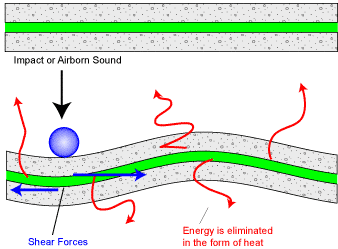
Magnesiacore.cA
Upgrade Your Drywall
Magnesiacore Inc.
Buy Direct - We Deliver
Magnesiacore Soundproofing Systems
Whether you are looking for a quieter living room, bedroom, or garage, or building a home theater, magnesiacore brings you an easy and inexpensive solution. Isolate and remove echo and reverberations, and hear sounds more clearly with a system that’s quick to assemble and more DIY-friendly than other options.
For existing rooms, apply a layer of magnesiacore (any thickness) with acoustical goo over existing walls, ceilings, and floors for remarkable acoustical improvement. Simple soundproof sheetrock solutions for the DIY and professional sound consultant or acoustical trade contractor; we offer improved materials and innovations for quietness in today's noisier environments.
Acoustical Goo is a sound Isolating Dampening Compound of the class of materials known as "viscoelastic." Acoustical goo does not harden; it remains soft between two layers of material, and dampens sound by consuming the energy in the sound waves as it travels between layers of magnesiacore. The dampening material and two magnesiacore sheets together act like a shock absorber to amortize the sound traveling through them.
How does it work?
Using constrained layer damping, sometimes referred to as CLD, a dampening material sandwiched between two stiff materials is sheared rigid. With Acoustical Goo sandwiched between two layers of magnesiacore, dampening occurs when the viscoelastic center is sheared. When bent, shear forces pull and stretch the dampening material. The unique polymeric construction of Acoustical Goo efficiently converts the mechanical energy to heat. The vibration energy is not only isolated, it is transformed and dissipated and thus removed.

With much higher density and elasticity, magnesiacore is superior to other sheetrock or drywall construction boards when combined with Acoustical Goo to provide the best combination for isolated mass dampening. Acoustical Goo is formulated specifically to neutralize sounds traveling in building walls, floors, and ceilings.
As refractory material, magnesia molecules respond to energy of sound waves much like other radiation by refraction, to enhance the Acoustical Goo's ability to dampen and neutralize the energy of the sound waves as they travel.
Our attractive flooring applications improve sound management in office, commercial, and residential environments through the "Isolated Mass Dampening of Sound Waves," which consumes acoustical energy rather than reflecting it.
This video shows how to make simple acoustical panels on existing walls with 9mm magnesiacore over Acoustical Goo.
Based on independent laboratory testing for acoustical material, 9mm (3/8") magnesiacore is superior to 16mm (5/8") gypsum board in an equal acoustical design.
In addition to magnesiacore being suitable for floors and even exteriors (unlike gypsum board), magnesiacore provides better acoustical performance by refracting sound energy waves. Moreover, the unique designs possible, like stapled magnesiacore to magnesiacore, can avoid short circuits, i.e., from screwing face sheets to framing work that permits sound to travel through structures.




Details for Walls, Ceilings and Floor Assemblies:
.jpg)
Recommended Acoustical Goo coverage is from 1 to 3 tubes per 4' x 8' panel (122cm x244cm) in uniform random layout (see figures below for methods).
Uniform random coverage of Acoustical Goo gives optimum performance across all sound frequencies.
Leaving patches uncovered using the same amount of Acoustical Goo results in thicker film when two sheets are together. This slightly improves low frequency performance at the slight expense of higher frequency performance


NOTE - Acoustical Goo takes approximately 30 days to set and reach optimum consistency to neutralize sounds waves. Although sound dampening occurs immediately by the system, it will increase dramatically over time and reach its maximum dampening performance when fully set.
A key feature of the above wall/floor assembly is the reduction in number of screws and fasteners between the face wall panel (that airborn sounds hit) and the structure (studs). Reducing the number of fasteners to no more than one every 16" (40cm) apart reduces the number of "short circuits" that sound can take after hitting the face wallboard. This method permits Acoustic Goo to function better between two sheets, since magnesiacore is stapled together separately from the studs.




Acoustical Assembly Test per ASTM E90
(5/8") ~16mm paperfaced gypsum drywall
STC 43 [16mm gypsum board] + [metal stud & batts] + [16mm gypsum board]
(~3/8") 9mm solid magnesiacore
STC 48 [9mm] + [metal stud & batts] + [9mm]
STC 50 [9mm / goo / 9mm] + [wood stud & batts] + [16mm gypsum board]
STC 55 [9mm / goo / 9mm] + [wood stud & batts] + [9mm / goo / 9mm]
STC 55 [9mm / goo / 9mm] + [metal stud & batts] + [9mm]
STC 60 [9mm / goo / 9mm] + [metal stud & batts] + [9mm / goo / 9mm]
Notes * STC 50 is typical code requirement for hotels, motels, apartments, condominiums, monasteries, and convents blocking approx. 50 dB (loud speech cannot be understood). STC 60 is typically specified for highly sensitive areas blocking approx. 60 dB (loud speech cannot be heard). It is estimated that 12mm (1/2") of magnesiacore applied to both sides of metal studs and batts will provide more than STC 50 to satisfy code.



